Altum angelfish (Pterophyllum altum) are beautiful fish that live in freshwater Amazon River in South America. Altum angelfish are popular among experienced fish keepers because of their unique appearance and the challenge they present in care. They need a large tank with lots of space to swim and water should be slightly acidic and not too hard. In this article, we’ll tell you where Pterophyllum altum inhabits, what makes it different from ordinary freshwater angelfish, as well as how to keep it, feed, select tank mates for it, and breed.
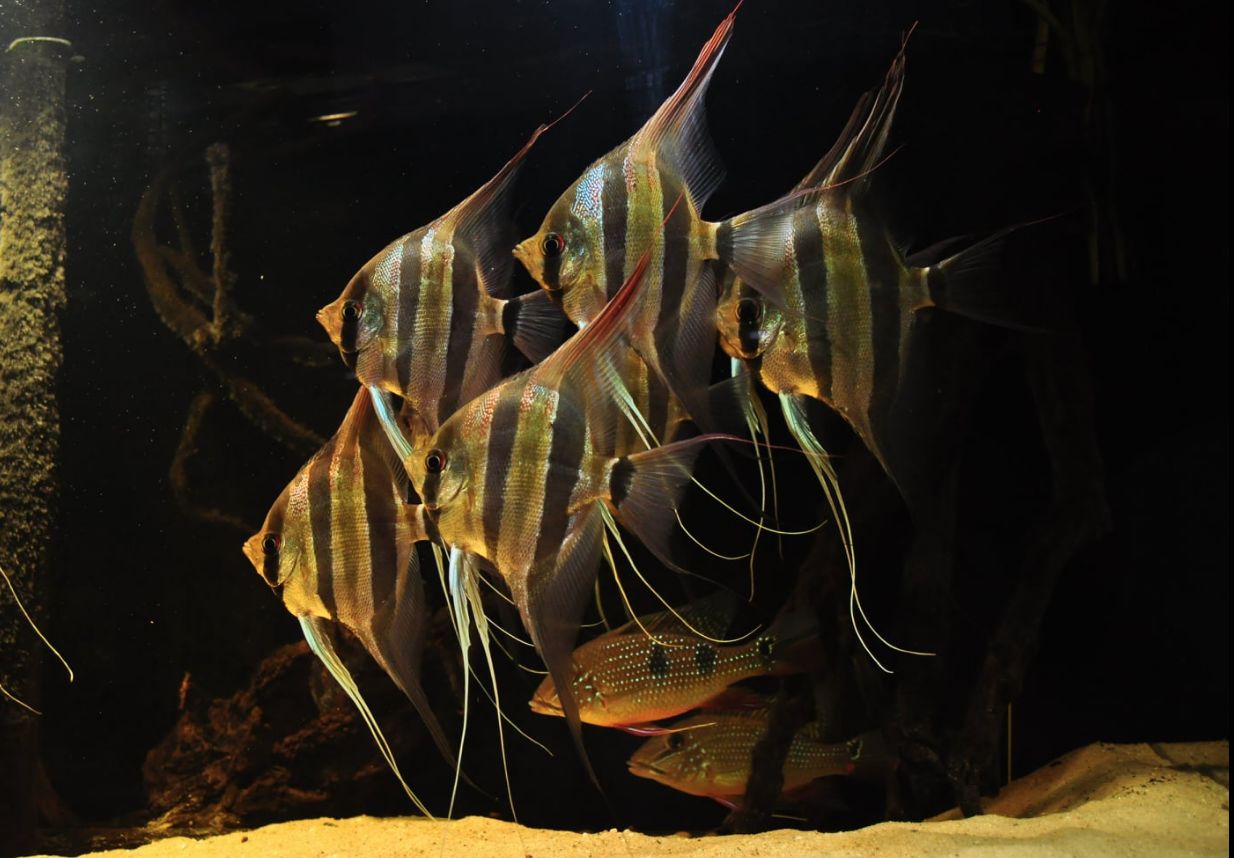
Contents
Habitat in the wild
Altum angelfish (lat. Pterophyllum altum) is one of three kinds of freshwater angelfishes, and this is the largest representative of its kind. Pterophyllum genus is widespread in South America, which has led to confusion when identifying many representatives of this genus in the wild. Nowadays, there are three classified kinds of this fish: Pterophyllum scalare, Pterophyllum altum, and Pterophyllum leopoldi.
The kind was first described by Jacques Pellegrin (1873 – 1944) in 1903. «Altum» translated from Greek means’ tall,’ which demonstrated the main difference between this kind and other Pterophyllum representatives – this is their strongly vertically stretched.
The altum angelfish habitat hasn’t been clearly defined yet. Still, it may safely be said that representatives of the kind can be encountered in the East of the Orinoco River basin, Southern Venezuela’s territory, in small and large river tributaries, and lakes formed after the rivers overflow.
Northern area of the fish habitat is limited to the Amazon River tributary Rio Meta, which is 100 km to the North from Puerto Ayacucho, another is located 800 km south in Rio Inírida and Rio Atabapo, where the first altum specimen was officially caught. A small group of altum angelfish kept at a depth of one and a half meters, under the shade of coastal bushes.
We can state with certainty that all known Pterophyllum kinds inhabit the area of 2500 km from the Orinoco to the Amazon River. However, where the habitat ends, we don’t know yet.
All kinds of these fish are encountered in black, transparent, and white waters, but more often in the first two.
The altum angelfish species caught in different places have visible differences in their coloring. For example, altum angelfish from the Orinoco River has more blue colors near its back and head with some small red spots scattered there. Those caught in Rio Inírida have significantly more red spots around their head and back, while fishes that dwell in Rio Atabapo demonstrate even more red color on the same areas of their body.
The fish’s typical natural biotope is a small lagoon or a stream deep in the jungle whose maximum depth during the dry season is about 2 meters. In such waters, pH value is within the range from 4.5 to 6.5, and it greatly depends on the season and location. Water temperature during a year varies from 28 to 31°C. During the rainy season, it may decrease up to 21°C. The maximum water hardness value is 10 dGH.
As for the water flow in natural biotopes – it can be both very slow and quite fast. In the latter case, better water oxygenation is provided. These well-aerated areas are the ones Pterophyllum altum prefers. Once the rainy season begins, huge rainforest areas become flooded. At that, the water level sometimes rises up to 10 meters high, and it stays at this level for many weeks.
The air temperature rises to 38°C in the shade. The upper water layer temperature is 32°C, as it gets deeper, the temperature decreases just at 1-2°C. The biotope bottom is usually sandy or clay.
Geophagus, apistogramma, discus dwell in the neighborhood. As for predators, anacondas and small caymans live there.
In the wild, altum angelfish live in small groups of 5-20 species of different ages. They prefer coastal areas, about 3 meters deep, thickly covered with aquatic plants. In biotopes with clay shores and bottom, many echinodorus kinds grow. Clay covered with a thick organics layer which increases when the rainy season comes is a good substrate for them.
In biotopes with a sandy bottom, it is covered with a thick layer of fallen leaves. Giant vallisneria grows on the bottom areas lighted with the sun. The underwater landscape is formed from fallen trees’ snags, which above water parts are covered with moss. There are rocks and roundstone piles along the river shores.
During rivers overflow, bushes growing along the shores get under water and become a shelter for many fishes, while their leaves are the perfect substrate for them to lay eggs.
Spring floods are the best time for fishes. This is when their living space becomes many times larger. As the dry season approaches, the water level decreases until the rivers return to their initial streamways.
During the time, a thick layer of fallen leaves accumulates in coastal backwaters where there is almost no flow. Such areas serve as a shelter for many small-sized fish kinds and spineless species, which form the basis of the altum angelfish diet. At the same time, fallen trees and other coastal vegetation remnants become perfect protection from sudden predators attack. When the fish sees them, it quickly hides in the labyrinth of snags and leaves.
By the end of the dry season, the water level reaches its minimum. Only some stone formations on the bottom of the waters are left as shelters for the altum angelfish in Amazonia. At low water level, altum angelfish and neighboring discus species head for these only safe places. Due to their flat body, they can easily move in these labyrinths of stones.
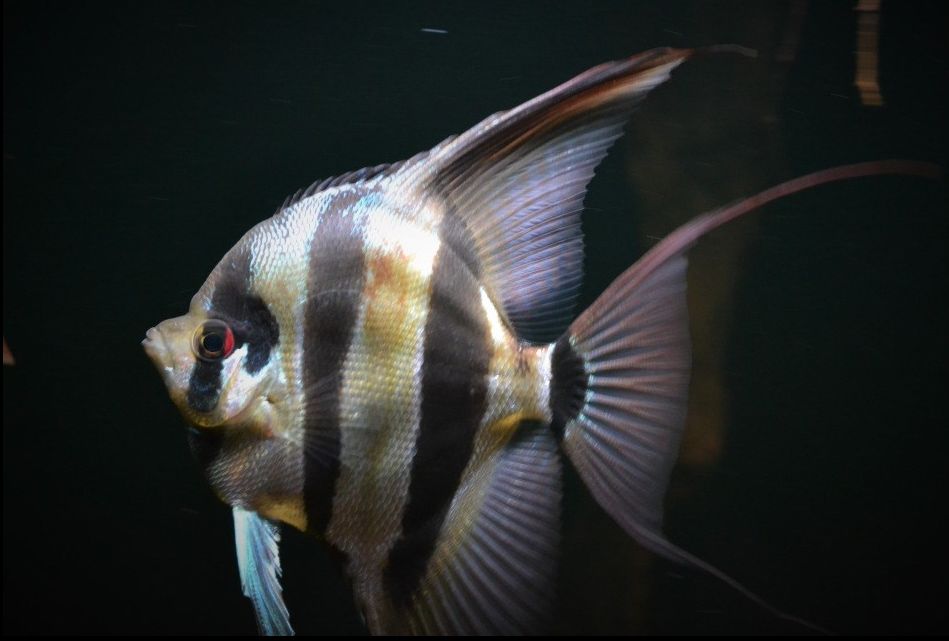
Description
They have a laterally compressed body with a tall and elongated dorsal fin, giving them a distinctive appearance compared to other angelfish species.
As mentioned above, altum angelfish is the largest representative among all Pterophyllum species. Their dorsal and anal fins sweep may reach up to 35-40 cm, and they are very long. These fins are both pearl gray. The first rays of the abdominal fin are filamentary and very long as well. The altum angelfish body is disk-shaped, quite flattened from sides, the snout is sharpened.
The basic body coloring varies from greenish-gray to olive drab with silvery glitter, and the back has a brownish-olive tint. There are four main lateral stripes on the body. Their color changes depending on the fish’s mood and behavior, and it can be saturated black, black-brown, or gray. The first stripe overpasses the fish’s eye, the second one starts from the short dorsal rays and ends near the anal fin beginning, the third one – from the top of the dorsal to the anal fin top, the fourth one starts at the beginning of the caudal fin.
| Characteristic | Description |
|---|---|
| Scientific Name | Pterophyllum altum |
| Common Names | Altum angelfish, Orinoco angelfish; altum angel; altum fish |
| Native Region | Amazon River basin in South America |
| Maximum Size | 15-40 cm (6-16 inches) |
| Body Shape | Tall and elongated, laterally compressed |
| Dorsal Fin | Tall and elongated, reaching up to half the body height |
| Coloration | Silver or gray body with vertical black stripes |
| Lifespan | Typically 5-10 years in captivity |
| Temperament | Generally peaceful, may become territorial during breeding |
| Tank Size | Minimum 75 gallons (284 liters) |
| Water Parameters | pH: 5.5-7.0, Temperature: 24-28°C (75-82°F) |
| Water Hardness | Relatively soft water with low to moderate hardness |
| Diet | Omnivorous, accepts high-quality flakes, pellets, and live/frozen foods such as brine shrimp, bloodworms, and small insects |
| Breeding Behavior | Open-water spawners, lay eggs on broad-leaved plants or surfaces |
| Difficulty Level | Challenging to care for, recommended for experienced aquarists |
| Popularity | Sought after by experienced hobbyists for their unique appearance and rarity |
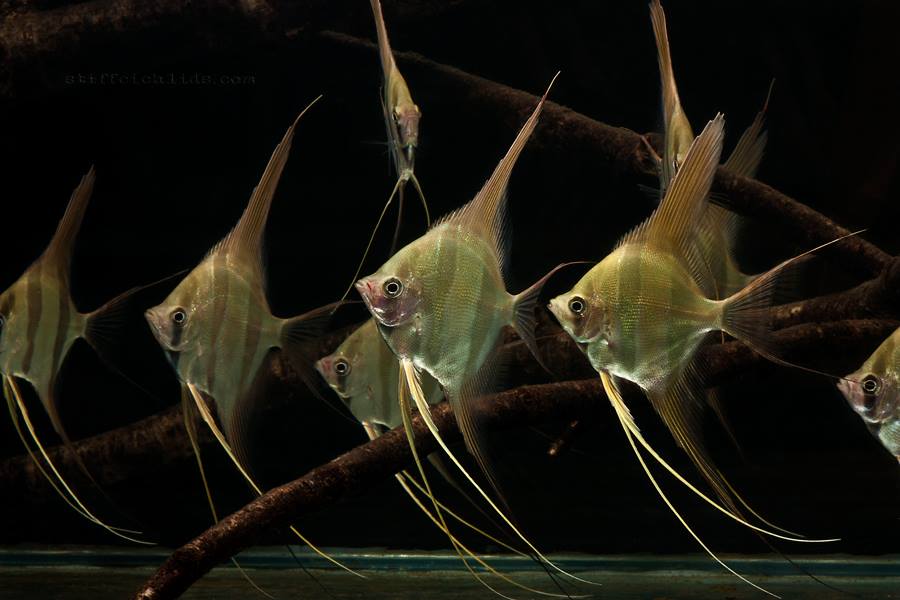
Pterophyllum altum VS Pterophyllum scalare
You can see between altum angels and angelfish not only due to altum tall body and long fins (which non of other Pterophyllum representatives have) but also due to its extremely pronounced snout, reddish color of its stripes, presence of additional wide stripes on its body (not found on other species’ body) and scales which are essentially smaller than those of other two fish kinds.
Altum differs from ordinary angelfish by its appearance. It is larger, slimmer, and tall bodied, it has large frons, and the snout is visually directed upward. Differences in appearance are especially visible among the new fish. They are distinct from their age mates of other kinds by their fascinating long fins.
As for other less visible appearance characteristics used when providing a scientific description of the altum angelfish, we can name the number of fin rays, scale rows, and pores along the lateral line.
Four dark, sometimes almost black (depending on the fish mode) vertical stripes are peculiar for Altum species. If the fish is stressed, their number may increase to seven. Newly appeared stripes have a paler color and appear between the main black ones. A one-year-old fish has its greenish-blue areas more visible on its forehead and back. The areas between them have red-brown coloring.
Here’s a simple comparison table highlighting the differences between Altum angelfish (Pterophyllum altum) and the common angelfish (Pterophyllum scalare):
| Altum Angelfish | Common Angelfish | |
|---|---|---|
| Scientific Name | Pterophyllum altum | Pterophyllum scalare |
| Origin | Amazon River basin in South America | Amazon River basin in South America |
| Size | Up to 15-40 cm (6-16 inches) | Up to 15 cm (6 inches) |
| Body Shape | Tall and elongated | Flatter and rounder |
| Dorsal Fin | Tall and elongated | Shorter and more rounded |
| Coloration | Silver or gray body with black vertical stripes | Varied color patterns, including silver, black, and marbled |
| Difficulty Level | More challenging to care for | Easier to care for |
| Tank Size | Requires a larger tank, minimum 150 gallons (568 liters) | Can be kept in smaller tanks, minimum 30 gallons (113 liters) |
| Water Conditions | Prefer soft and slightly acidic water (pH 5.5-7.0) | Tolerate a broader range of water conditions |
| Temperament | Generally peaceful but can be territorial during breeding | Generally peaceful, but aggression can occur during breeding |
| Breeding | Challenging to breed in captivity | More commonly bred in captivity |
| Availability | Less common and sought after by experienced hobbyists | More readily available in the aquarium trade |
Atabapo altum angelfish
The Altum Angelfish (Pterophyllum altum) from the Atabapo River is a specific geographical variant or population of Altum angelfish. The Atabapo River is located in Venezuela, and the Altum angelfish found in this region are highly sought after by fish enthusiasts due to their unique characteristics. The Altum Angelfish from the Atabapo River is often referred to as Atabapo Altum.
The Altum Atabapo angelfish are known for their larger size and more elongated body shape compared to other Altum angelfish populations. They can grow up to around 15 inches (38 cm) in height, making them one of the largest freshwater angelfish species. They also have more extended dorsal and anal fins, adding to their majestic appearance. The vertical black bands on their body may be less prominent or even absent in some individuals.
In terms of care requirements, Altum Atabapo angelfish have similar needs to other Altum angelfish populations. They prefer soft, slightly acidic water with temperatures ranging from 78 to 84°F (25 to 29°C). Providing a spacious tank with plenty of vertical swimming space and suitable hiding spots is essential for their well-being. Due to their size, Altum Atabapo angelfish require larger aquariums to accommodate their growth and natural behavior.
Difficulties in keeping
These are moderately challenging to keep in a tank. They are quite peaceful (towards the fish of equal size), active, and hardly stand polluted water. Any sharp movements near the tank scare them, not to mention these inside the tank, as well as sharp changes of light intensity. You can keep them in a community tank with high walls, but not with fin nipping fishes.
Altum can be a perfect decoration of any large tank. Its movements are gracious and light. The first species that appeared in amateurs’ tanks were caught in the wild. Their price was quite high. Even nowadays, despite significant success in their breeding, you can see ‘wild’ species on sale.
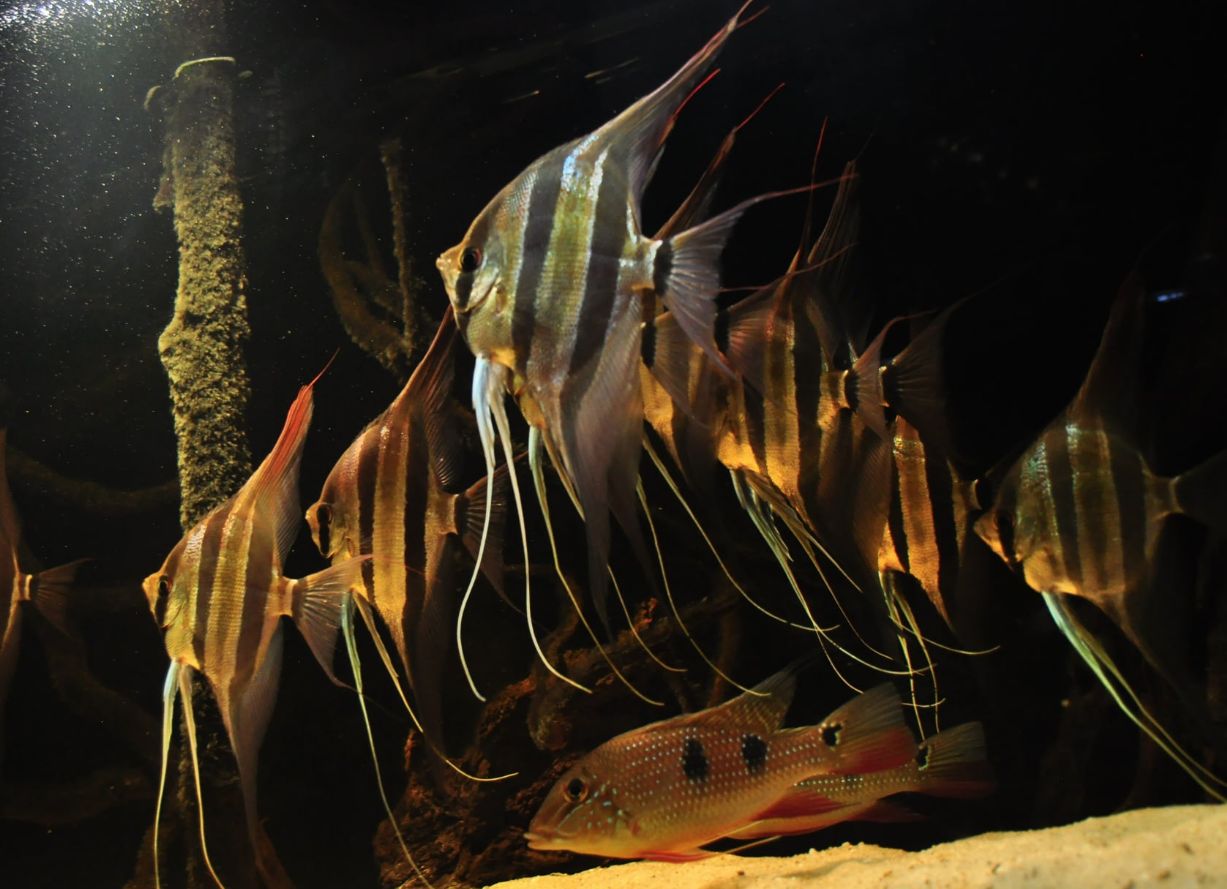
Keeping in a tank
Lifespan
As for the altum angelfish lifespan in a tank, it varies from 5 to 10 years. However, with proper care, a healthy Altum angelfish can sometimes live longer, reaching up to 15 years or more in exceptional cases. Often the females live about 6-12 months longer than males. Tank water temperature is a crucial factor in this respect. The higher is the temperature, the faster are metabolic processes of the fish, which decreases its lifespan correspondingly. Providing a suitable environment, balanced nutrition, and regular maintenance can contribute to their longevity. It’s important to note that individual lifespans can vary depending on factors such as genetics, diet, water quality, and overall care provided.
Tank size
A quite spacious tank is required to keep the altum fish. A tank size of 150 gallons (700 liters) can be considered a minimal one, even though I know the cases of keeping the altum angelfish successfully in smaller tanks. Quite a lot depends on the number of species in the tank, water filtration, and tank mates.
One adult species requires at least 11 gallons (50 liters) of water.
They react to peripheral distractions like a discus. Thus you should consider thoroughly where the tank will be located. A noisy and crowded place won’t do definitely. However, a quiet and secluded spot won’t be an all-heal recipe. Rather often, they react to abrupt light or sound signals, get frightened and hit the tank walls, and get injured.
The wild species are timider than those bred in captivity. Sometimes such behavior may be caused by diseases that can’t be diagnosed at early stages.
Tank bottom substrate and decorations
There may be no substrated at all. Such tanks are called tanks with hygienic design and are often used to keep discuses. As for the decorative value of such tanks, it is almost absent. However, a glass bottom of such a tank can be maintained relatively clean to avoid a bacterial clump appearance.
Tanks for altums can have decorations, bottom substrate, and plants. A compromise, in this case, can be to cover the tank bottom with a thin layer of clean sand. This is the bottom that some of the natural altum angelfish biotopes have. Such a sand layer is a perfect place for nitrifying bacterium development. They utilize food leftovers and prevent the appearance of pathogenic agents.
Decides, such a substrate makes it possible to suck away some amount of the sand from time to time, wash it, and put it back to the tank then. Also, it easier for the altum angelfish to the food on this kind of bottom substrate.
Plants in the tank
There are almost no limitations in terms of plants you can put in such a tank. Altums are indifferent towards the latter so that they won’t damage them. Provided with such substrate layer thickness, the plants don’t have a chance to strike roots properly. Thus, they should be planted in containers.
Ceramic containers styled to look like natural stones will suit better for this purpose. Such stones with plants put on the sandy bottom look quite appealing in the tank.
It is preferable to use plants with long and wide leaves — for example, various kinds of Echinodorus.
It is equally important to provide optimal lighting mode both for the plants and for the altum angelfish. You can do it by creating well-lighted and shaded areas in the tank. Light day duration in the tank should be 10-12 hours. It’d be good to install an automatic system to turn on/off the tank lighting at the same time every day. If there are several lamps in the lighting fixture, it’d be perfect if you can turn them on one by one gradually during an hour interval.
In the wild, the light and shade constantly change in the altum angelfish biotope. For this reason, there are lighted and shaded areas there at the same time. In shaded areas, altum finds its shelter and feels relatively safe there. Thus, it is required to create such areas in the tank.
Additionally, it’d be good if you put some oak, beech, or maple tree leaves on the substrate. The leaves will add to the general impression you get from the tank decoration. Besides, they also prevent the appearance of harmful bacteria. You should replace the leaves once in two weeks.
Tall-growing plants create a safe environment for the altum angelfish and decrease their stress level, while large leaves can be a perfect spawning substrate for them. For the same purpose, you can use large branched snags.
Water parameters and temperature
The main requirement of successful altum keeping is a high quality of the tank water. In the wild, their habitats have very soft water. In a tank, considering its small volume, they are kept in the water with middle hardness since it is easier to maintain its basic hydrochemical parameters stable in this case.
As for the tank water parameters, they are close to the ones used for keeping a discus, except for some peculiarities. The water temperature for altum should be a bit lower, about 27-28°C. There should be a quite strong aeration in the tank and water intermixing. Altum, unlike discus fish, prefers stronger water flow in a tank.
You can keep altum in water with medium hardness, and neutral or a bit shifted to alkaline parameters pH. Yet, the water quality is of crucial importance. To maintain it properly, you need efficient filtration and regular water renews: it should be performed weekly, 20-25% of the total tank volume.
A minimal number of pathogenic organisms in the water is achieved by using a UV sterilizer. The tank should be equipped with an efficient filtration system (both mechanical and biological). Filters’ performance should be failure-free. Just one hour of the filter’s downtime may lead to a significant decrease of bacterial colonies that participate in biological water purification, and as a result, nitrites level will rise.
At moderate mechanical and nitric load on water, high-quality large capacity filters preserve their performance for many months. Frequent cleaning of the filtering material isn’t recommended. Those that are used for biological purification are washed only in tank water.
To maintain the concentration of nitrates at a safe level, you should renew the tank water weekly, and the renewed amount should not less than a quarter of the total tank volume. Except mentioned above, you should timely remove all life wastage that appears, such as food leftovers, egestas, rot off plant segments.
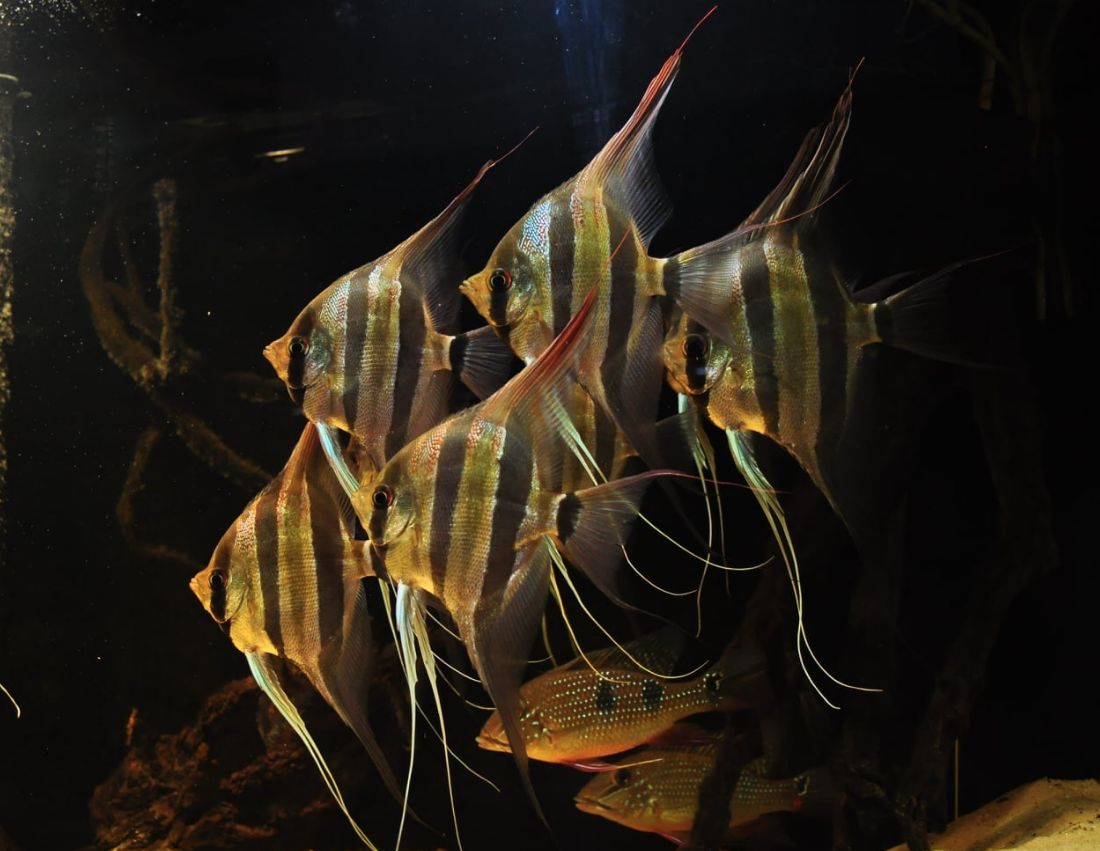
Tank mates
In a community tank, fishes that dwell in middle and bottom water layers can be altum angelfish tank mates. Corydoras catfish are bottom-dwelling fish that can coexist peacefully with Altum angelfish. They help keep the substrate clean by scavenging for leftover food and debris. Make sure to choose a species that prefers similar water parameters as Altum angelfish, such as Corydoras sterbai or Corydoras panda
For the middle water layer, active middle-sized fishes will do. Thus the following tank dwellers can be good tank mates for altum: black neon tetra, neon tetra, bloodfin tetra, cockatoo cichlid, corydoras julii, emperor tetra, flame tetra, panda cory, pygmy cory, ram cichlid, rummy nose tetra. The schooling behavior of cardinals can provide a visually appealing display alongside Altum angelfish.
All tetra and corydoras kinds above-mentioned are schooling fishes, so you should keep them in a tank in groups of at least 10 species. All the species should be healthy and pass 4 weeks guaranteed. The same requirement is true for bottom-dwelling fishes.
You shouldn’t keep фltum with such small fishes as oto catfish or bristlenose pleco juveniles. Although these algae-eaters are rather welcome in tanks, their small size sooner or later provokes altum to treat them as its prey. When catching the juvenile, altum often can’t swallow them since the latter bristles its sharp fins and gets stuck in the hunter’s mouth, often harming it a lot. Often such injuries lead to the fish death.
Feeding
In the wild, Altum’s diet is rather diversified. It includes insects, worms, crustaceans, other fishes’ juveniles. For this reason, many aquarists prefer feeding the fish with live or frozen food. However, this food can’t meet the fish dietary needs completely, and besides, they are potentially dangerous in terms of infecting the tank.
It is strictly prohibited to feed the altum angelfish with forced meat of warm-blooded animals (for example, cows). The fish doesn’t have special ferments to digest this kind of meat.
A perfect solution, in this case, is to use high-quality dry food. It is fully balanced, contains vitamin and probiotic complexes, which allows maintaining the tank water clean. All food of questionable quality should be removed from diet. It is good to feed it with various insects and cut earthworms from time to time.
The food should be given in a portion that the altum angelfish can eat in several minutes. For this reason, you should not feed it in the evening shortly before you turn off the tank lighting.
This altum angelfish is rather gluttonous. Thus, if you don’t feed it in portions, you may observe it having difficulty of respiration or flatulence. The fish can stay like this for several hours, and then it’ll get back to its normal condition.
Gender differences: male vs female
You can define the altum angelfish gender for certain only during its spawning period. Otherwise, all secondary characteristics don’t provide an ironclad guarantee of exact fish definition. Thus, adult male species are a bit larger than females, have a taller body and sharp forehead. Also, they have more contrast coloring. But all mentioned above is quite relative and strongly depends on the tank conditions.
Often one can define the altum angelfish gender by the size of its fins. For example, males have two or more elongated rays on the end of their anal fin, while females have just one such ray. Also, the fish’s gender can be determined by its behavior, but for this, you’ll need some experience of keeping altums in a tank.
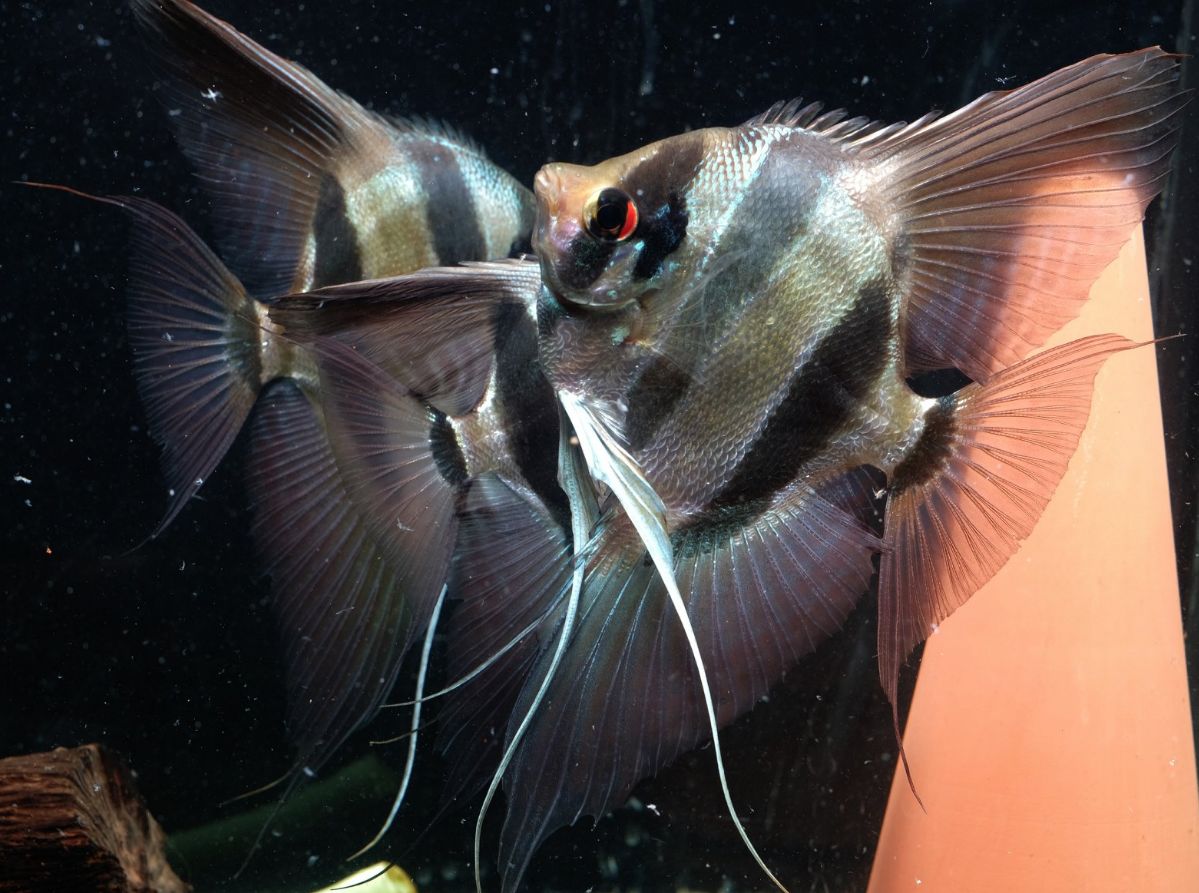
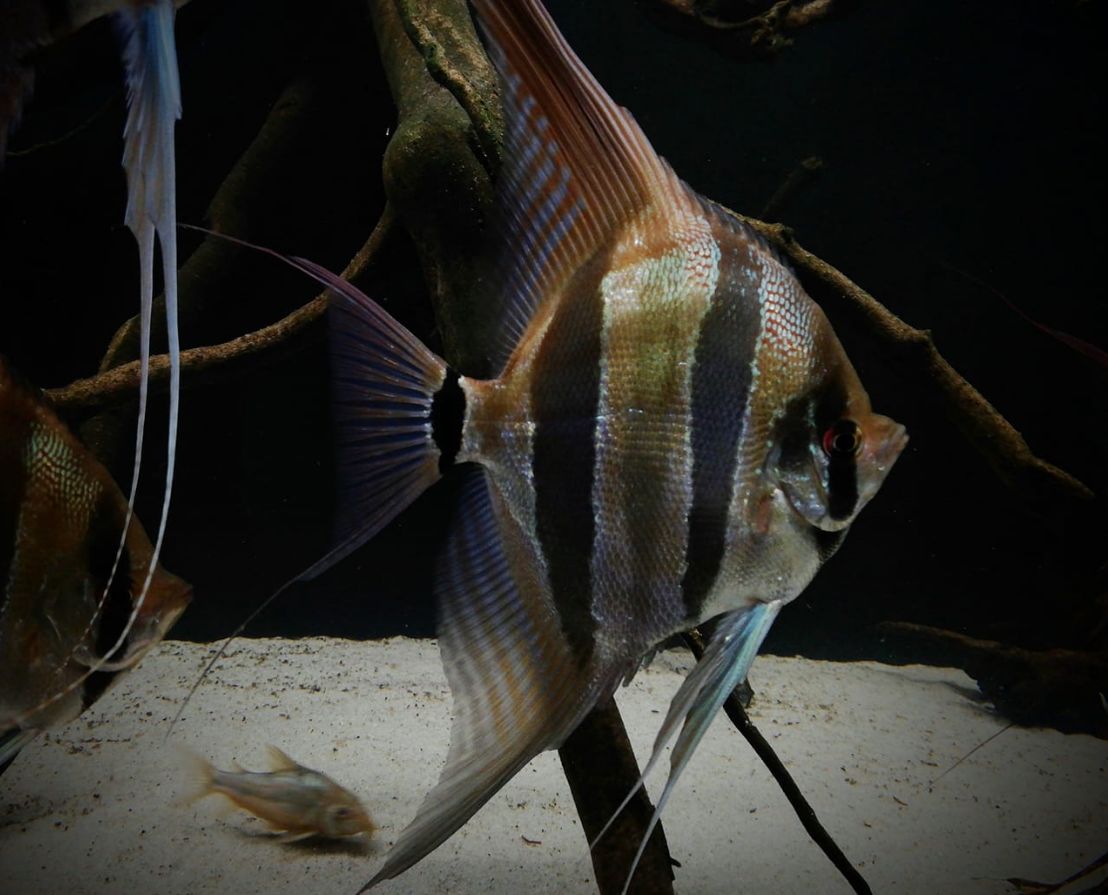
Breeding
Like most other cichlid species, spawning in the wild happens according to seasonal cycles. That’s why it is recommended to put the altum angelfish for spawning in a tank within the period from April to June. Usually, at this time, couples are formed, and they get separated from the rest, occupy some specific territory and guard it against intruders.
Such behavior is demonstrated in rather spacious tanks. At this moment, you can put the breeders into a separate tank or leave them where they are. The latter is more preferable since species (especially wild ones) are timider than discuses.
If there are no species of different gender in the tank, you may sometimes observe a false spawning when two species of the same gender imitate a couple.
To stimulate the spawning, you should correct the tank water parameters. For successful spawning, the water should be soft and has excessive acidity. The following water parameters can be considered optimal: electrical conductivity from 100 to 150 mS/cm, pH — from 5,5 to 6,0.
The diet should be as diversified as possible but given in moderate portions.
As a rule, a separated couple uses a tank wall or a large plant leave as its spawning substrate.
You can additionally offer ceramic cones or tubes for the breeders as well as some other objects with a flat surface or even parts of plumbing pipes.
The breeder couple becomes very aggressive towards other tank dwellers, and there some external characteristics that show this. The altum angelfish coloring becomes very contrast at this time, as well as the black spot above the fish’s eye. Such change of the coloring says about the oncoming spawning. If you can see a rather visible terebra of a female (2-3 mm thick and 4 mm long) and the male has a sharpened genital papilla (3mm long), this means that there are not more than 2 days left till spawning. During this period, if possible, don’t make noise or any abrupt movements near the tank.
The breeders start to protect actively the substrate they’ve selected for spawning. The closer the spawning time is, the more their behavior changes. They start to show courtesy towards each other. You can see them spreading and shaking their fins a little, swimming around each other.
Usually, at about midday, the female starts to lay eggs that the male fertilizes at the same time. The female lays eggs in lines: from the bottom upwards. At that, the eggs are very close to each other. The spawning continues for about 1.5 hours, during which the female can lay from 300 to 500 eggs.
The clutch is considered fertilized if, several hours later, you can see protein spots on the eggs. It indicates that an embryo will be growing there. The eggs are almost transparent with a slight yellowish tint.
After laying the eggs, the breeders start taking care of their clutch in turns by fanning it with their fins and removing some mud particles from it. At tank conditions, the first eggs often become blurred and die several hours after spawning. In a day, the whole clutch will die.
Two reasons can cause such a sad finale. The first is too high water hardness for eggs to grow, the second and the most possible one – is the presence of many pathogenic organisms in tank water.
Even removing the clutch from the community tank or a spawning tank to a specially prepared volume with a small number of bacteria may have low effect if the eggs were exposed to negative factors influence for longer than 90 minutes. Even if some eggs won’t die and the larvae hatch, it is very likely that they have some physical defects.
To get the maximum number of juveniles, you should remove the clutch from the spawning tank to another volume right after the spawning is over. To get quality water in such a tank, you should use an internal filter with a peat filler. At that, the peat amount shouldn’t be large. It should be enough only to stabilize the water acidity. It is possible to add antibacterial substances into the water, but it doesn’t always bring the desired result. Using UV sterilizers is more efficient in this case.
About 60 hours later, the larvae hatch. They hang on the substrate or get on the bottom.
After eating their yolk bag, the juveniles become about 5 mm large and start swimming as a school around the tank looking for food. This is when you should start to feed them with the smallest live food.
The first three days after they start to feed are the most crucial ones. For good development and growth, the juveniles require sufficient water volume, frequent feeding, good filtration, and water renews.
About 10-12 later, the appearance of the juvenile starts to change. Altums like discuses start growing taller at this period of time, and it defines their future body shape. Day after day, the juveniles start to resemble adult fishes more and more. Their fins grow, and the body gains its typical shape.
On the 18-the day, the lateral stripes appear on the juvenile’s body. When the juvenile’s fins sweep becomes 4 cm large, you should put them into a larger tank.
For successful growing the juveniles, there should be about 40-50 species for 100 liters of water.
Now you can include everything they can swallow in their diet. The food portion should be enough for the altum angelfish to eat completely in 10 minutes. The optimal number of feeding is 5-6 times a day.
Food leftovers and fish waste products should be occasionally sucked away from the tank combined with partial water renew (50 % of the tank volume, twice a week). This is necessary to minimize the number of pathogenic microflora in the water.
In general, altums grow more uniformly if compared to angelfishes. At that, the tank size plays an important role. Gradually, you start to keep the grown-up juveniles using tap water with pH equal to 7,5, carbonate hardness of 4 dKH, and electric conductivity equal to 280 mS/cm. The tank water temperature should be maintained at about 28°C.
At the age of one year old, the fin sweep of altum kept at optimal tank conditions may reach 20 cm, and once it becomes reproductive (in 2 years), it can be 30 cm. In spacious tanks with high walls, by the age of 3 years old this parameter may grow up to 35-40 cm.